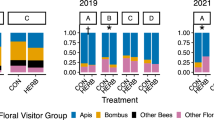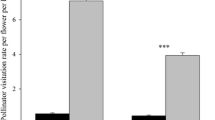Abstract
Antagonistic biological interactions with flower consumers and pathogens may influence reproductive success of flowering plants, affecting population dynamics and natural selection for floral traits. However, ecological and evolutionary consequences of the interactions may depend on both spatial and temporal patterns of the interactions. In a forest metapopulation ofPrimula sieboldii E. Morren, an endangered clonal plant species, we measured between-subpopulation patterns of seed sets and interactions with an influential flower consumer, a rove beetle,Eusphalerum bosatsu Watanabe, and a specific smut fungal pathogen,Urocystis tranzschelina (Lavrov) Zundel (Ustilaginales), for three years. Mean female fertility (seed set per flower) for individual subpopulations fluctuated moderately among years but was highly variable within each year among the five subpopulations studied. In two subpopulations, the impact ofEusphalerum beetle, was sufficiently large to result in almost complete failure in seed production over eight years including the three study and five previous preliminary observation years. In the two other subpopulations, seed set failure was caused by infection by the smut fungus. Infected capsules which constitute 10–30% of the capsules produced in the subpopulations were filled with ustilospores instead of seeds. In the subpopulation that escaped flower damage byEusphalerum beetles and smut fungal infection, seed sets of both pin and thrum flowers were much higher than in the other subpopulations. The spatial restriction of individual antagonistic agents to a part of subpopulations suggest that dispersal of the agents, as well as the mode of spatial subdivision of the plant population would be important for determining the overall effects of antagonistic interactions on plant performances at the metapopulation level.
Similar content being viewed by others
References
Alexander, H. M. (1990) An experimental field study of anther-smut disease ofSilene alba caused byUstilago violacea: patterns of spore deposition and disease incidence.Evolution 43: 835–847.
Alexander, H. M. and J. Antonovics (1988) Disease spread and population dynamics of anther-smut infection ofSilene alba caused by the fungusUstilago violacea.Journal of Ecology 76: 91–104.
Augspurger, C. K. (1981) Reproductive synchrony of a tropical shrub: Experimental studies on effects of pollinators and seed predators onHybanthus prunifolius (Violaceae).Ecology 62: 775–788.
Beedlove, D. E. and P. R. Ehrlich (1968) Plant-herbivore coevolution: Lupines and lycaenids.Science 162: 671–672.
Bertness, M. D., C. Wise and A. M. Ellison (1987) Consumer pressure and seed set in a salt marsh perennial plant community.Oecologia 71: 190–200.
Burdon, J. J., A. M. Jarosz and G. C. Kirby (1987) Pattern and patchiness in plant-pathogen interactions-its causes and consequences.Annual Review of Ecology and Systematics 20: 119–136.
Cappuccino, N. (1987) Comparative population dynamics of two goldenrod aphids: spatial patterns and temporal constancy.Ecology 68: 1634–1646.
Dieringer, G. (1991) Variation in individual flowering time and reproductive success ofAgalinis strictifolia (Scrophulariaceae).American Journal of Botany 78: 497–503.
Ganders, F. R. (1979) The biology of heterostyly.New Zealand Journal of Botany 17: 607–635.
Goodman, D. (1987) How do any species persist? Lesson for conservation biology.Conservation Biology 1: 59–62.
Goldburg, R. J. (1987) Sequential flowering of neighboring goldenrods and the movements of the flower predatorEpicauta pennsylvanica.Oecologia 74: 247–252.
Gomez, J. M. (1993) Phenotypic selection of flowering synchrony in a high mountain plant,Hormathophylla spinosa (Cruciferae).Journal of Ecology 81: 605–613.
Gross, R. S. and P. A. Werner (1983) Relationships among flowering phenology, insect visitors, and seed-set of individuals: Experimental studies on four co-occurring species of goldenrod (Solidago: Compositae).Ecological Monograph 53: 95–117.
Hanski, I. (1983) Coexistence of competitors in patchy environment.Ecology 64: 493–500.
Harrison, S. and C. D. Thomas (1991) Patchiness and spatial pattern in the insect community on ragwortSenecio jacobeae.Oikos 62: 5–12.
Hassell, M. P., H. N. Comins and R. M. May (1991) Spatial structure and chaos in insect population dynamics.Nature 353: 255–258.
Hastings, A. (1990) Spatial heterogeneity and ecological models.Ecology 71: 426–428.
Howe, H. F. and L. C. Westley (1988)Ecological relationships of plants and animals. Oxford University Press, New York.
Inouye, R. S., G. S. Byers and J. H. Brown (1980) Effects of predation and competition on survivorship, fecundity, and community structure of desert annuals.Ecology 61: 1344–1351.
Kakishima M. Y. Yamazaki, Y. Okayama and I. Washitani (1995)Urocystis tranzscheliana, a newly recorded smut fungus onPrimula sieboldii from Japan.Mycoscience 36: 239–241.
Levin, S. A. (1974) Dispersion and population interactions.American Naturalist 108: 207–225.
Louda, S. M. (1982a) Limitation of the recruitment of the shrubHaplopappus squarosus (Asteraceae) by flower- and seed-feeding insects.Journal of Ecology 70: 43–53.
Louda, S. M. (1982b) Distribution ecology: variation in plant recruitment in relation to insect seed predation.Ecological Monographs 52: 25–41.
Louda, S. M. (1989) Predation in the dynamics of seed regeneration. pp. 25–51.In M. A. Leck, V. T. Parker and R. L. Simpson (eds.)Ecology of soil seed banks. Academic Press, New York.
Louda, S. M., and M. A. Potvin (1995) Effect of infloresence-feeding insects on the demography and lifetime fitness of a native plant.Ecology 76: 229–245.
Ollerton, J. and A. J. Lack (1992) Flowering phenology: an example of relaxation of natural selection?Trends in Ecology and Evolution 7: 274–276.
Pacala, S. W., M. P. Hassell and R. M. May (1990) Host-parasitoid associations in patchy environments.Nature 344: 150–153.
Quinn, J. F. and A. Hastings (1987) Extinction in subdivided habitats.Conservation Biology 1: 198–208.
Richards, J. H. (1986)Plant breeding systems. Allen and Unwin, London.
Root, R. B. (1973) Organization of a plant-arthropod association in simple and diverse habitats: the fauna of collards (Brassica oleracea), Ecological Monographs 43: 95–124.
Schemske, D. W. and C. C. Horvitz (1989) Temporal variation in selection on a floral character.Evolution 43: 461–465.
Scheffe, H. (1959)The analysis of variance. John Wiley & Sons, New York.
Solbreck, C. and B. Sillen-Tullberg (1986) Seed production and seed predation in a patchy and time-varying environment. Dynamics of a milkweed-tephritid fly system.Oecologia 71: 51–58.
Sokal, R. R. and F. J. Rohlf (1981)Biometry. Freeman, San Francisco.
Takahashi, H., I. Washitani, H. Namai and Y. Kuroda (1992) Conservation biology ofPrimula sieboldii in the Yatsugatake University Forest. I. Distribution, habitat characterstics and phenology.Bulletin of Tsukuba University Forests 6: 275–286. (in Japanese with English summary).
Tilman, D. (1994) Competition and biodiversity in spatially structured habitats.Ecology 75: 2–16.
Thrall, P. H. and A. M. Jarosz (1994) Host-pathogen dynamics in experimental populations ofSilene alba andUstilago violacea. I. Ecological and genetic determinants of disease spread.Journal of Ecology 82: 549–559.
Washitani, I., H. Namai, R. Osawa and M. Niwa (1991) Species biology ofPrimula sieboldii for the conservation of its lowland-habitat population: I. Inter-clonal variations in the flowering phenology, pollen load and female fertility components.Plant Species Biology 6: 27–37.
Washitani, I., R. Osawa, H. Namai and M. Niwa (1994a) Patterns of female fertility in heterostylousPrimula sieboldii under severe pollinator limitation.Journal of Ecology 82: 571–579.
Washitani, I., M. Kato, J. Nishihiro and K. Suzuki (1994b) Importance of queen bumble bees as pollinators facilitating inter-morph crossing inPrimula sieboldii.Plant Species Biology 9: 169–176.
Wennstrom, A. and L. Ericson (1990) The interaction between the clonal herbTrientalis europaea and the host specific smut fungusUrocystis trientalis.Oecologia 85: 238–240.
Wiens, J. A. (1989) Spatial scaling in ecology.Functional Ecology 3: 385–397.
Zimmerman, M. (1980) Reproduction inPolemonium: pre-dispersal seed predation.Ecology 61: 502–506.
Author information
Authors and Affiliations
Rights and permissions
About this article
Cite this article
Washitani, I., Okayama, Y., Sato, K. et al. Spatial variation in female fertility related to interactions with flower consumers and pathogens in a forest metapopulation ofPrimula sieboldii . Res Popul Ecol 38, 249–256 (1996). https://doi.org/10.1007/BF02515734
Received:
Accepted:
Issue Date:
DOI: https://doi.org/10.1007/BF02515734




